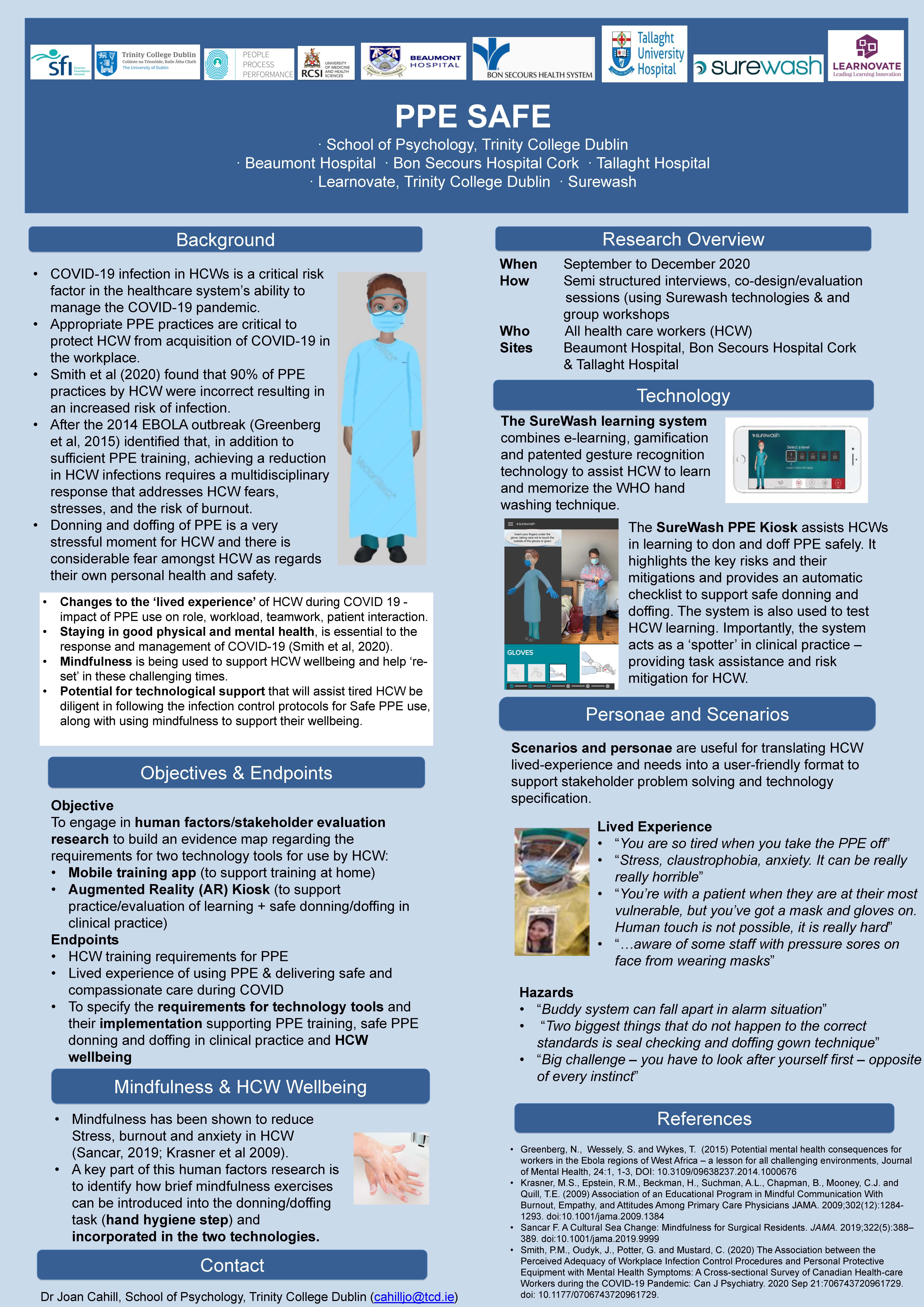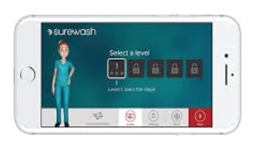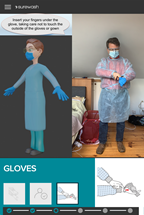Personal Protective Equipment (PPE) Safe
Project Overview & Objectives
This PPE Safe project addresses training, risk management, workplace stress and safety issues in the use of Personal Protective Equipment (PPE) by healthcare workers (HCW).
The objective is to engage in stakeholder evaluation research to build an evidence map regarding the requirements for two technology tools:
- Mobile training app (to support HCW training in safe donning and doffing of PPE)
- Augmented Reality (AR) kiosk
- To support practical training in safe donning and doffing of PPE and the assessment of this training (i.e. test – yielding pass/fail)
- To support safe donning and doffing of PPE in clinical practice
This project approach and allied technology solution adopts a human factors and systems approach to socio-technical systems development. As such, human factors drive the (1) problem framing/definition, (2) methodology and HCW involvement/engagement, (3) technical solution specification and (4) implementation strategy and design.
The project is funded by Science Foundation Ireland (SFI), as part of the COVID-19, Rapid Response Fund.
Click the image below to expand our poster.
Click the image below to expand our poster.
TCD Research Team & Project Partners
CIHS, Human Factors Team |
Dr Joan Cahill, Principal Investigator & Human Factors Researcher |
Alison Kay, Human Factors Researcher |
|
Vivienne Howard, Human Factors Researcher |
|
Clinical Partners |
Beaumont Hospital |
Technology Partner |
Surewash |
Learning Design |
Learnovate, Trinity College Dublin |
Background & Mapping the Problem Space
COVID-19 infection in HCWs is a critical risk factor in the healthcare system’s ability to manage the COVID- 19 pandemic. Appropriate PPE practices are critical to protect HCW from acquisition of COVID-19 in the workplace.
The rapid recruitment and training of HCW into frontline work during the current COVID-19 pandemic has given rise to the need to provide rapid training for HCW in the correct techniques for putting on and removing PPE (‘donning’ and ‘doffing’). As with any physical learning process it takes multiple repetitions to learn and memorise the protocol with feedback from a “spotter” to catch potential errors. A 2019 CDC study found that 90% of PPE practices by HCW were incorrect resulting in an increased risk of infection. Studies of the Ebola outbreak identified that, in addition to sufficient PPE training, achieving a reduction in HCW infections requires a multidisciplinary response that addresses HCW fears, stresses, and the risk of burnout. (Li, Y., Wang, H., Jin, X. et al., 2018).
Staying in good physical and mental health, is essential to the response and management of COVID-19 (Smith, 2020). The COVID-19 pandemic is having profound impacts on the health and wellbeing of healthcare workers (Sim, 2020). Based on previous outbreaks, such as SARS, it is expected that health-care workers will be one of the occupational groups at highest risk of disease transmission (Yeung, 2004; Hsin & Macer, 2004). This increased risk along with the attendant increases in workload and fear of infecting family and household members, is likely to be associated with poorer mental health (Smith, 2020; Smith, Oudyk, Potter, Mustard, C., 2020).
As argued by Smith (2020), it is important to identify workplace factors linked to mental health that can be changed. While PPE and infection control procedures are often discussed as measures to reduce virus transmission, we also need to understand their importance in the context of HCW mental health. This is especially important, given that the mental health impacts of COVID-19 may continue beyond the COVID 19 pandemic (Smith, 2020).
Addressing safe donning/doffing of PPE and implementing new safety/risk management practices and behaviours for HCW requires both process and cultural change. As pointed out by Fitzpatrick & O Riordan (2016), “Bottom-up approaches focussing on quality improvement and innovation generated by front line staff are seen as a lever for sustainable change”.
Mindfulness & Health Care Worker (HCW) Wellbeing
Recent studies have found that strengthening employer-based infection control strategies is likely to have important implications for mental health symptoms among health-care workers (Smith, Oudyk, Potter, Mustard, C., 2020).
Mindfulness has been used to support physical and mental wellbeing and to prevent /reduce impact of PTSD for HCW. Mindfulness has been used for stress reduction and building resilience to avoid vocational fatigue and burnout (Mulcahy, 2020). These techniques can be used to manage stress pertaining to the impact of work stressors on wellbeing, performance, and safety, along with the management of the home/work interface.
In relation to the PPE donning/doffing task, mindfulness practices can be integrated in the design of the hand hygiene task.
New PPE Technologies, Mindfulness & Surewash System
Given the high reported COVID-19 infection rate among HCWs there is a significant potential for a technological support that will assist tired HCWs be diligent in following the infection prevention and control protocols for donning and doffing PPE. This can include embedding mindfulness steps in the design of such technologies supporting the hand hygiene task – addressing concomitant issues pertaining to HCW fears, stresses, and the risk of burnout.
The SureWash learning system combines e-learning, gamification and patented gesture recognition technology to assist HCW to learn and memorize the WHO hand washing technique |
|
The SureWash PPE Kiosk assists HCWs in learning to don and doff PPE safely. It highlights the key risks and their mitigations and provides an automatic checklist to support safe donning and doffing. The system is also used to test HCW learning. Importantly, the system acts as a ‘spotter’ in clinical practice – providing task assistance and risk mitigation for HCW. |
|
Contacts
For more information, please contact
- Dr Joan Cahill: cahilljo@tcd.ie




